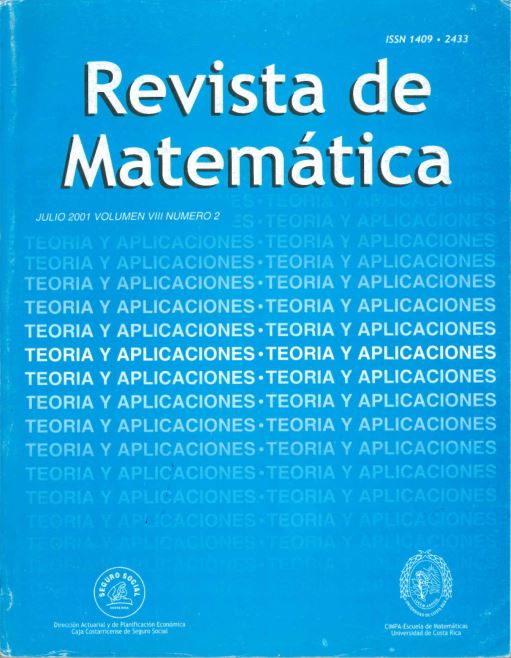Resumen
El espacio de los polígonos de n lados, inmersos en el espacio euclídeo de tres dimensiones, consiste de una variedad suave en la cual los puntos corresponden a nudos lineales a trozos o “geométricos”, mientras que los arcos corresponden a isotopías que preservan la estructura geométrica de esos nudos. Se describe la topología de estos espacios para los casos n = 6 y n = 7. En ambos casos, cada espacio consta de cinco componentes, aunque contiene sólo tres (cuando n = 6) o cuatro (cuando n = 7) tipos topológicos de nudos. Por lo tanto la “equivalencia geométrica de nudos” es estrictamente más fuerte que la equivalencia topológica. Este hecho se demuestra con el nudo trébol hexagonal y el nudo doble heptagonal, los cuales, a diferencia de sus contrapartes topológicas, no son reversibles. Se discutirán también las extensiones de estos resultados a los casos n ≥ 8.
Citas
Adams, C. C. (1994) The Knot Book: An Elementary Introduction to the Mathematical Theory of Knots. W. H. Freeman and Co., New York.
Alexander, J. W.; G. B. Briggs (1927) “On types of knotted curves”, Annals of Mathematics 28: 562–586.
Babini, J. (1952) Historia Sucinta de la Matemática, Colección Austral, Espasa-Calpe Argentina, S.A., Buenos Aires, Argentina.
Calvo, J. A. (1998) Geometric Knot Theory: The Classification of Spatial Polygons with a Small Number of Edges. Ph.D. Thesis, University of California, Santa Barbara.
Calvo, J. A. (2000) “The embedding space of hexagonal knots”, Preprint, North Dakota State University, Fargo, ND. (Aparecerá en Topology and its Applications 110(2).)
Calvo, J. A.; Millett, K. C. (1999) “Minimal edge piecewise linear knots”, Ideal Knots, A. Stasiak, V. Katrich y L. H. Kauffman (Eds.), Series on Knots and Everything, vol. 19, World Scientific, Singapore: 107 – 128.
Curcio Rufo, Q. La Historia de Alejandro Magno (Historiarium Alexandri Magni Macedonis Libris), libro III, caṕıtulo II.
Adams, C. C.; Brennan, B. M.; Greilsheimer, D. L.; Woo, A. K. (1997) “Stick numbers and composition of knots and links”, Journal of Knot Theory and its Ramifications 6(2): 149–161.
Gordon, C. McA.; Luecke, J. (1989) “Knots are determined by their complements”, Bulletin of the American Mathematical Society (New Series) 20 (1): 83–87.
Furstenberg, E.; Lie, J.; Schneider, J. (1998) “Stick knots”, Chaos, Solitons and Fractals 9(4-5): 561–568.
Jones, V. F. R. (1985) “A polynomial invariant for knots via von Neumann algebras”, Bulletin of the American Mathematical Society (New Series) 12(1): 103–111.
Freyd, P.; Yetter, D.; Hoste, J.; Lickorish, W. B. R.; Millett, K. C.; Ocneanu, A. (1985) “A new polynomial invariant of knots and links”, Bulletin of the American Mathematical Society (New Series) 12(2): 239–246.
Hoste, J.; Thistlethwaite, M.; Weeks, J. (1998) The first 1,701,936 knots, Mathematical Intelligencer 20(4): 33–48.
Kauffman, L. H. (1987) On Knots, Annals of Mathematics Studies, vol. 115, Princeton University Press, Princeton, NJ.
Kirkman, T.P. (1885) “The enumeration, description and construction of knots with fewer than 10 crossings”, Transactions of the Royal Society of Edinburgh 32: 281–309.
Lickorish, W. B. R. (1962) “A representation of orientable combinatorial 3-manifolds”, Annals of Mathematics (Second Series) 76: 531–540.
Lickorish, W. B. R., An Introduction to Knot Theory, Graduate Texts in Mathematics, vol. 175, Springer, New York.
Litle, C. N. (1885) “On knots, with a census of order ten”, Transactions of the Connecticut Academy of Science 18: 374–378.
Meissen, M. (1998) “Edge number results for piecewise-linear knots”, Knot Theory, Polish Academy of Sciences, Warsaw: 235–242.
Millett, K. C. (1994) “Knotting of regular polygons in 3-space”, Journal of Knot Theory and its Ramifications 3(3): 263–278; también en Random Knotting and Linking, K. C. Millett y D. W. Sumners (Eds.), Series on Knots and Everything, vol. 7, World Scientific, Singapore: 31–46.
Negami, S. (1991) “Ramsey theorems for knots, links, and spatial graphs”, Transactions of the American Mathematical Society 324(2): 527–541.
Randell, R. (1988) “A molecular conformation space”, MATH/CHEM/COMP 1987, R. C. Lacher
(Ed.), Studies in Physical and Theoretical Chemistry, vol. 54, Elsevier Science, Amsterdam: 125–140.
Randell, R. (1988) “Conformation spaces of molecular rings”, MATH/CHEM/COMP 1987 R. C. Lacher (Ed.), Studies in Physical and Theoretical Chemistry, vol. 54, Elsevier Science, Amsterdam: 141–156.
Randell, R. (1994) “An elementary invariant of knots”, Journal of Knot Theory and its Ramifications
(3): 279–286; también en Random Knotting and Linking, K. C. Millett y D. W. Sumners (Eds.), Series on Knots and Everything, vol. 7, World Scientific, Singapore: 47–54.
Reidemeister, K. (1983) Knot Theory, traducido del alemán y editado por L. F. Boron, C. O. Christenson y B. A. Smith, BCS Associates, Moscow, ID.
Rolfsen, D. (1976) Knots and Links, Mathematical Lecture Series, vol. 7, Publish or Perish, Houston, TX.
Tait, P. G. (1898) “On knots, I, II, III”, Scientific Papers, vol. 1, Cambridge University Press, Cambridge: 273–347.
Thurston, W. P. (1982) “Three-dimensional manifolds, Kleinian groups and hyperbolic geometry”, Bulletin of the American Mathematical Society (New Series) 6(3): 357–381.
Thurston, W. P. (1986) “Hyperbolic structures on 3-manifolds. I. Deformation of acylindrical manifolds”, Annals of Mathematics (Second Series) 124(2): 203–246.
Thurston, W. P. (1997) Three-Dimensional Geometry and Topology. Vol. 1, editado por S. Levy, Princeton University Press, Princeton, NJ.
Tutton, A. E. H. (1922) Crystallography and Practical Crystal Measurement, vol. 1, Macmillan and Co. Ltd., London.
Wallace, A. H. (1960) “Modifications and cobounding manifolds”, Canadian Journal of Mathematics 12: 503–528.
Whitney, H. (1967) “Elementary structure of real algebraic varieties”, Annals of Mathematics 66: 545–556.
Ziegler, G. M. (1995) Lectures on Polytopes, Graduate Texts in Mathematics, vol. 152, Springer Verlag, New York.





